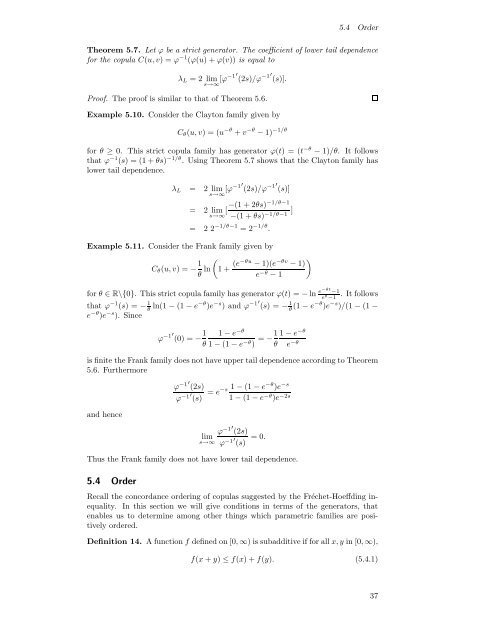Modelling Dependence with Copulas - IFOR
Modelling Dependence with Copulas - IFOR
Modelling Dependence with Copulas - IFOR
You also want an ePaper? Increase the reach of your titles
YUMPU automatically turns print PDFs into web optimized ePapers that Google loves.
5.4 Order<br />
Theorem 5.7. Let ϕ be a strict generator. The coefficient of lower tail dependence<br />
for the copula C(u, v) =ϕ −1 (ϕ(u)+ϕ(v)) is equal to<br />
λ L = 2 lim<br />
s→∞ [ϕ−1′ (2s)/ϕ −1′ (s)].<br />
Proof. The proof is similar to that of Theorem 5.6.<br />
Example 5.10. Consider the Clayton family given by<br />
C θ (u, v) =(u −θ + v −θ − 1) −1/θ<br />
for θ ≥ 0. This strict copula family has generator ϕ(t) =(t −θ − 1)/θ. It follows<br />
that ϕ −1 (s) =(1+θs) −1/θ . Using Theorem 5.7 shows that the Clayton family has<br />
lower tail dependence.<br />
λ L = 2 lim [ϕ −1′ (2s)/ϕ −1′ (s)]<br />
s→∞<br />
=<br />
−(1 + 2θs)−1/θ−1<br />
2 lim [<br />
s→∞ −(1 + θs) ]<br />
−1/θ−1<br />
= 2 2 −1/θ−1 =2 −1/θ .<br />
Example 5.11. Consider the Frank family given by<br />
C θ (u, v) =− 1 (<br />
θ ln 1+ (e−θu − 1)(e −θv )<br />
− 1)<br />
e −θ − 1<br />
for θ ∈ R\{0}. This strict copula family has generator ϕ(t) =− ln e−θt −1. It follows<br />
e θ −1<br />
that ϕ −1 (s) =− 1 θ ln(1 − (1 − e−θ )e −s )andϕ −1′ (s) =− 1 θ (1 − e−θ )e −s )/(1 − (1 −<br />
e −θ )e −s ). Since<br />
ϕ −1′ (0) = − 1 θ<br />
1 − e −θ<br />
1 − (1 − e −θ ) = − 1 1 − e −θ<br />
θ e −θ<br />
is finite the Frank family does not have upper tail dependence according to Theorem<br />
5.6. Furthermore<br />
and hence<br />
ϕ −1′ (2s)<br />
ϕ −1′ (s) = e−s 1 − (1 − e−θ )e −s<br />
1 − (1 − e −θ )e −2s<br />
ϕ −1′ (2s)<br />
lim<br />
s→∞ ϕ −1′ (s) =0.<br />
Thus the Frank family does not have lower tail dependence.<br />
5.4 Order<br />
Recall the concordance ordering of copulas suggested by the Fréchet-Hoeffding inequality.<br />
In this section we will give conditions in terms of the generators, that<br />
enables us to determine among other things which parametric families are positively<br />
ordered.<br />
Definition 14. A function f defined on [0, ∞) is subadditive if for all x, y in [0, ∞),<br />
f(x + y) ≤ f(x)+f(y). (5.4.1)<br />
37
















